More on the coffee pinotage, and Bertus 'Starbucks' Fourie
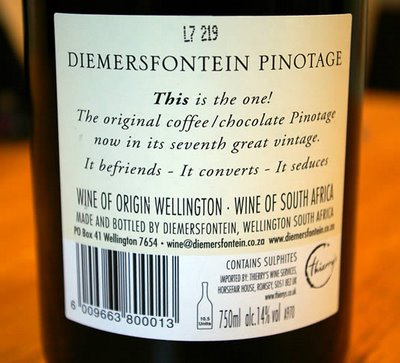
Labels: Pinotage, south africa, winemaking
mainly wine...

Labels: Pinotage, south africa, winemaking
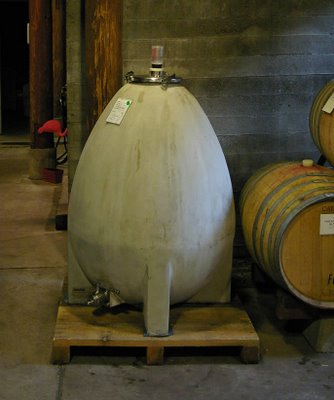 OK folks, it's competition time. Can anyone tell me what this is, and what it is used for? Best answer gets a prize.
OK folks, it's competition time. Can anyone tell me what this is, and what it is used for? Best answer gets a prize.Labels: winemaking
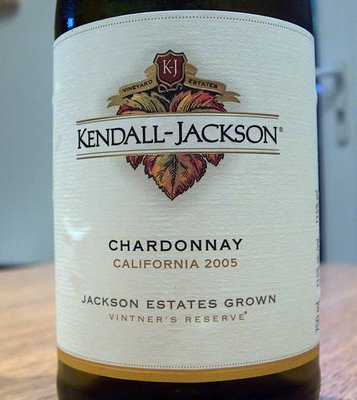 The title is somewhat misleading; it's meant to be provocative, but there's a more serious side to this question. Perhaps I should have re-titled it 'the world's most important Chardonnay'. This wine is significant.
The title is somewhat misleading; it's meant to be provocative, but there's a more serious side to this question. Perhaps I should have re-titled it 'the world's most important Chardonnay'. This wine is significant."In a milestone ruling for the wine industry, a county court in California has ruled that a winemaking process constitutes a trade secret belonging to a winery and may not be divulged by the winemaker to subsequent employers or consulting clients."
It's a ruling that upset the industry. There are only so many ways to make wine, and most of them have been practised for generations. If you are a winemaker who leaves a previous winery, legal shackles preventing you from using the techniques you utlized in your previous employment could effectively finish your career.
So what is the wine like? First, let's judge this in context. In the USA it sells for $13, but loads of places have it for just a few cents under $10. That's a fiver over here. At this price, it's a no-brainer. In the UK, retail is £8.99 through Morrisons, which puts it into a slightly different bracket, although it can certainly compete at this price level.
My first impression is of richness allied with freshness. There's some spicy peach, apricot and fig richness, coupled with fruit sweetness, but offset by good acidity and a citrussy focus. I'm getting a hint of grapefruit, too, on the finish. The sweetness here is alluring - I'm not sure how much is due to the fruitiness or whether this is a wine that still has a bit of residual sugar in the mix. If it wasn't for some of the more distinctive Chardonnay (fig, tropical fruit) characters and the subtle oak, the texture here - with sweetness offset by acidity - would lead me in the direction of a Riesling Kabinett from the Mosel. If points mean anything to you, I'd give this 88/100. Given the quantities made, the low price, the impact this wine has had, and the market penetration, this is one of the world's most important Chardonnays.
One further historical note. In the mid-1990s Gallo launched their 'Turning Leaf' range, including a Chardonnay. The logo for Turning Leaf has a picture of a vine leaf in its autumn colours, an image that appears (to my eye) to be somewhat similar to the autumnal vine leaf that's the visual hook for the KJVRC label. KJ sued Gallo about this and lost. Twice (once on appeal). Interestingly, one of my editors recently asked me a question about the 'Kendall Jackson Turning Leaf Chardonnay'.Labels: california, Chardonnay, winemaking
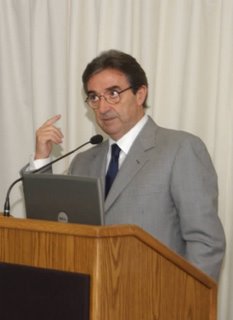 Riccardo Cotarella is one of the most famous figures in Italian wine. He's a consulting winemaker to a slew of different estates, many of whom have caught the eye of Robert Parker. But not everyone is a fan of him: like that other famous consultant Michel Rolland, he's been criticised for making wines that taste a bit similar. Wines that impress, but which have been divorced from their origins. He was in London last week presenting many of these wines at a seminar, where he defended himself thus:
Riccardo Cotarella is one of the most famous figures in Italian wine. He's a consulting winemaker to a slew of different estates, many of whom have caught the eye of Robert Parker. But not everyone is a fan of him: like that other famous consultant Michel Rolland, he's been criticised for making wines that taste a bit similar. Wines that impress, but which have been divorced from their origins. He was in London last week presenting many of these wines at a seminar, where he defended himself thus:'To say that a consulting winemaker will make the same wine using the same grape and vinification techniques in different countries or even different areas of the same country is a complete stupidity. The people making these claims wouldn’t know the difference between a grape vine and a fig tree! In my work with the students at Viterbo University where I am a professor of Oenology we have demonstrated that using the same varietal from the same vineyard with the same treatment in both the vineyard and the winery will produce two very different wines when you vinify the grapes that come from the top of the vineyard on the top of the hill vs. those from the bottom of the same vineyard...90% of the character of a wine comes from the terroir, not the grapes.'This reads right. Yes, we beleive in terroir, and that it's the way to go for fine wine. But Cotarella fails to acknowldege here that terroir itself is actually quite fragile, and is easily lost - most commonly by picking too ripe and using interventionist winemaking. If you want to bring out terroir - the sense of place in a wine - you have to work hard at your viticulture and take care not to mess up in the winery. It's possible for consultant winemakers to introduce techniques such as extended cold macerations, long hang times, and invasive new oak usage that can obscure origins. And I have to disagree with the last statement. I think the grape variety is very important, otherwise there wouldn't be an insistence that Pinot Noir is the sole red variety in Burgundy, for example. This grape happens to be the best lens through which the Burgundy terroirs can be viewed, if you like. Or, we could say that 90% of the character of a wine can come from the terroir, but only if you let it.
Labels: Italy, terroir, winemaking
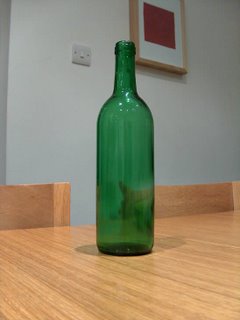 Got home to find several large boxes in the living room. Turned out to be 100 bottles from the Quinn Group, for the inaugural vintage (here) of my English wine that I intend to bottle in the next few weeks. Arriving soon will be 100 Diams (the closure I've chosen - it's taint free - and I don't have a screwcap line here so that wasn't an option - other taint-free in-neck closure options would be to use ProCork [the membrane cork] or synthetics, both of which would have suited my needs fine). So far the wine hasn't seen any sulfur dioxide, but I'll probably add just a little at bottling.
Got home to find several large boxes in the living room. Turned out to be 100 bottles from the Quinn Group, for the inaugural vintage (here) of my English wine that I intend to bottle in the next few weeks. Arriving soon will be 100 Diams (the closure I've chosen - it's taint free - and I don't have a screwcap line here so that wasn't an option - other taint-free in-neck closure options would be to use ProCork [the membrane cork] or synthetics, both of which would have suited my needs fine). So far the wine hasn't seen any sulfur dioxide, but I'll probably add just a little at bottling.Labels: closures, winemaking